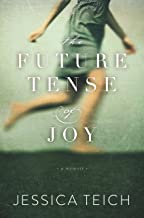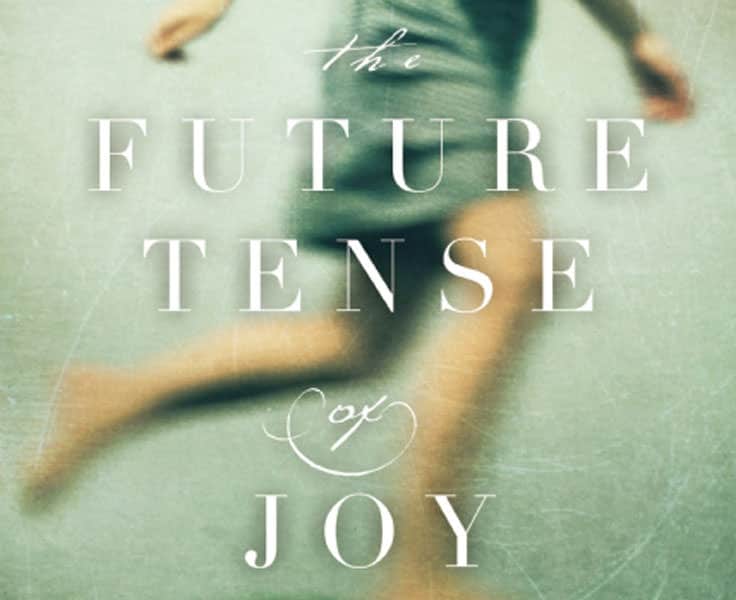The Future Tense of Joy by Jessica Teich
For a sneak peek of Jessica Teich’s memoir, The Future Tense of Joy, check out the excerpt below.
INTRODUCTION
Survivors remember the past in pieces. Not necessarily “before” and “after,” which would be easier. It’s more like time melts into Dali-like puddles, or convulses, slamming together faces and events. Psychologists often speak of a distortion in time afterward, as though the trauma occurred only moments before, but some- times the pain is so buried it ceases to exist. Then it springs up suddenly, like an allergy, even when it seems there’s no irritant. Or descends, like a fine but malevolent mesh.
That was true for me, but I could never write about my experience as a “survivor.” Even the word seemed bloodless, badly lit. I’d had so many privileges: an education at Yale, then at Oxford as a Rhodes scholars. I had a lovely husband and children; two daughters with their father’s long lashes and love of puns. But I felt trapped behind a scrim, like the smoked glass of an antique mirror, with life on the other side, tantalizing and remote. What happened when I was a child was holding me hostage, as surely as if I’d been stolen away.
There is a moment, stepping onto a plane, when you may hesitate at the threshold, nervous to leave the safety of one world, uncertain of the world beyond. This book takes place at that juncture, a crucial moment for my family, when I tried to make the pieces of my life cohere. Its sections are like those shards of experience, but the path they chart is not specific to me. For we have all been broken or betrayed.
Life is the part that happens after. When we move toward hope, toward peace, toward the healing of our hearts.
PART ONE BEGINNINGS
The fear of life . . . is the beginning of all evil.
—Rebecca West
1.
Eight and a half minutes. That’s how long it takes to walk from the bus stop to the dance studio, if you’re twelve years old and long legged, like my older daughter, Isabel. Especially if you’re focused, as I’ve warned her—repeatedly—to be.
The bus stop, at the corner of Olympic and Stewart, anchors an area in transition. For every sushi bar, there’s a gentlemen’s club with a name like “Silver Reign” (you can imagine the age of the clientele). There are auto-body shops and acu-therapy clinics and a veterinary hospital advertising its dedicated caring partners. When I drove past the day before, casing the joint, I thought the sign said dedicated caring parents. That’s what I’m trying to be.
At the little tabernacle next door, a neon sign beseeches need faith? Yes, I’m afraid I do.
I need a lot of faith because Isabel is a thinker, often lost in a book. She finds the real world less compelling than Narnia or Middle-earth. I’ve often urged her to live more deeply in three dimensions. So how could I refuse when she wanted to take the school bus to the stop near the dance studio, then walk to class? It was just a little walk: eight and a half minutes.
But I was as shocked as if she’d decided to project herself astrally to Mars. I wanted to say no, but Michael, my husband, wouldn’t let me. “Don’t make her feel afraid.”
He’d seen her do things—like trying to open a door with her elbows—that he knew my fears had inspired.
“Do you know how many dozens of germs are on doorknobs?” I would ask him.
“It doesn’t matter,” he’d reply. “There’d be no one left on the planet if you could die from a doorknob or a water fountain or a computer screen.”
I hadn’t even considered the dangers of water fountains. But I said yes to her anyway. Of course she could get off the school bus alone, then proceed to the dance studio.
I was plotting: If she reached the bus stop at 3:46 pm, she would be safely at the dance studio by 3:54 pm.
By 3:30 pm I was in position. I’d parked all the way down Stewart, near the construction site of the new Santa Monica College campus, far enough away that Isabel wouldn’t recognize the car. She wouldn’t have recognized it anyway, I knew. She wouldn’t have been looking.
But she had to be looking. For eight and a half minutes, she was the solar center of the universe. She had to pay attention to the scruffy young man pacing back and forth, holding an envelope. What was in the envelope? A kilo of heroin? A knife? And the couple, arguing twenty feet farther down the sidewalk. What if their fight escalated to blows, with my daughter walking past?
Isabel had to be watching out for all this, and more. Wouldn’t she? No matter. I would be watching. I would follow, several steps behind, until she swung open the door of the Westside School of Ballet.
When Isabel was younger, Michael took dozens of photo- graphs of her in front of those bright yellow caution signs: warning: feral pig in Hawaii when she was a baby; dangerous surf near a beach in Laguna when she was six; falling ice next to the ski lift in Mammoth when she was seven; beware electrical shock at an artist’s studio when she was nine. He did it for me, because he wanted me to believe the world was safe.
Needless to say, I was unconvinced.
I feared that she might sense my presence. We were connected that way. I, too, was remote, a reader, a dancer.
So, of course, I hid. Midway between the bus stop and the ballet school. The shrubbery was hardly concealing: mostly sad-looking ivy and impatiens embarrassed to be taking up space. I managed to find a small bend in the bushes, strewn with discarded sandwiches and cigarette butts and a used condom. Yuck.
Quickly, I found a place that offered better camouflage. I was on a mission. I would not be daunted by a busted beer bottle and a packet of Cheetos coated with dirt.
A ash of bright yellow: the school bus approaching. I knelt behind the shrub.
3:46 pm, like clockwork, Isabel disembarked, the skirt of her school uniform hiked up dangerously. Dangerously, because she could earn a demerit slip if it was more than “a cellphone and a half” above her knee. (When did the cellphone become a unit of measurement?) Her shirttail ventured out from beneath her cardigan, and she was wearing both shoes, which was a good sign. Last year she got off the school bus wearing only one shoe. How do you lose one shoe during the school day?
As she approached, I hunched down farther. Something crunched beneath my boot. I didn’t dare think what it might be. Years ago, I proudly took our new puppy for a walk, parading her like a prom queen, only to glance back and see her devouring half of a dead raccoon. I hoped the other half wasn’t underneath my feet.
The corner of Stewart and Olympic featured a cacaphony of white and yellow lines, and three plastic posts jutting out of the pavement, like Popsicle sticks. Next to the sticks was a curved area painted with stripes; then a single lane; then a double yellow lane with insouciant white dashes; then an opposing lane, and a stop sign smack in the middle. Isabel had to negotiate all that just to get from one side of the street to the other. She might as well have been surfing the Farallon straits.
This intersection was livelier than Times Square: a scrum of boys with skateboards; a day laborer in a Dodgers cap; a huddle of scruffy Silicon Valley–types, looking more distracted than dangerous. They could be counted on to destroy our children’s minds, but probably not to menace them.
There was a motorcyclist who didn’t slow down, let alone stop, at the stop sign. stop means “soft tap on pedal”—I learned that at traffic school—but he didn’t even do that. A man wearing docksiders leaned against a telephone pole. Had a guy in boat shoes ever terrorized anyone? Another man sported a t-shirt that read “Nobody knows I’m gay.”
A boy raced by on his bicycle, holding his phone instead of the handlebars. He wasn’t wearing a helmet. I wondered if his mother knew. A little girl clattered past in her tap shoes. This corner felt almost exhilarating, like a microcosm of the world.
Years ago, in a children’s bookstore, I heard the mother of a toddler ask, “Do you have a DVD he can watch of someone going to the grocery store and the post office and the bank?”
Just take him to the grocery store and the post office and the bank, I wanted to tell her. Let him live in the real world. He’ll love it. And as long as he’s strapped in his stroller, he’ll be safe.
Isabel stopped at the crosswalk, looked left, then left again. When she reached the middle, near the stop sign, she looked right, then right again. All of which was fine, except that, each time she looked, she also gestured with undulating arms, her mermaid hair owing behind her. She looked more like a synchronized swimmer than a pedestrian. There’s a difference between really looking and performing the act of looking. I’d have to talk with her about that when she got home.
But the only trouble she encountered was at the door of the studio. She was shouldering her dance bag, satin ribbons trailing, and a backpack no self-respecting Sherpa would lift. She had to turn sideways to fit through the doorway.
Another point for discussion. But when I went to pick her up that first day, all I said was,
“How was class?” “Good.”
“How was taking the bus to class?” “Good.” But I knew better. I knew that she had traversed the Bermuda Triangle and barely survived.
Every day for the next week, between 3:32 pm and 3:55 pm, I hid in the bushes. I found a deerstalker in my closet, a relic of my graduate student days, and thought it made the perfect disguise. In Southern California, you rarely need a tweed hat, especially one with earflaps and a pair of built-in visors. But the cap had finally come in handy, although I resembled Sherlock Holmes less than Inspector Clouseau.
Day after day, I saw many of the same men, loitering. They would nod to me as I lowered myself into the bushes, awaiting Isabel’s bus. I recognized the dog groomer who regularly parked here to smoke weed. The guy with bulging biceps, haranguing his parking meter. The pizza delivery man.
Another baby ballerina hurried past. Just you wait! I wanted to warn her mother. It gets harder; they get bigger; they want more. Soon your tiny person will demand her freedom. Soon you’ll be waiting here, just like me.
Every afternoon at approximately 3:46 pm, Isabel got off the bus, gesturing to the right and to the left, never really looking at the cars themselves, or making eye contact with the drivers, or any of the other things I had taught her to do. Sometimes she added a little pirouette. I would have to talk to her about that, too.
But how could I? She didn’t even know I was there. I came to wonder whether pre-teens, like infants, have a sense of object impermanence. When I wasn’t with her, I ceased to exist.
But she and her younger sister were the strongest reasons for my existence. To nurture them and help them thrive. To let them feel their freedom, that endless, elastic feeling when the time between school and supper feels completely unbounded. I remembered lying in the grass as a little girl, ear to the ground, listening for the other side of the world. Life seemed mysterious, but also intelligible, reliable. There were rules, but it didn’t matter if you didn’t know them. You would discover them soon enough. Was that still true, even now?
When would I—could I—hand my older daughter over to the universe? How would I ever feel that she was safe?
After a week, when my vigil at the corner of Stewart and Olympic began to resemble a sit-in, I could tell by the lemony light that a heat wave was coming on. I’d have to trade my deerstalker for a straw hat. Luckily, I had a closetful. But would that make me more conspicuous?
As I mulled this over from my perch in the bushes, Isabel approached, and I pulled my cap deeper over my ears.
Then she said, evenly, “Mommy, I can see you. I know you’re watching.”
She kept walking, calling back over her shoulder, “Besides, it’s a crosswalk, not a crack den.”
I sprang up, brushing aside the leaves and the litter of wrappers, not to greet her, or to make light of the absurdity of my situation, but to demand: “HOW DO YOU EVEN KNOW WHAT A CRACK DEN IS?”
In that moment, I recognized my madness. My fears had made me crazy enough to stalk my own daughter. (Which, admittedly, is better than stalking someone else’s daughter.) I couldn’t do this anymore.
I had to let Isabel go, so she could feel her life, all the luck of it, the beauty and sweetness and surprise.
She was ready to be free.
She was as equipped for freedom as any twelve-year-old could be.
She was longing to be free. And so was I. But I was dogged by more than a fear of dirty doorknobs.
What frightened me was harder to quantify, or disinfect. I was afraid of proximity to other people, all of whom seemed inscrutable, volatile. I routinely left an empty stool on either side of me at a sushi bar, or fled the elevator if another passenger seemed unwell. I never accepted a tissue from someone’s pocket, or a Tic Tac from her purse. But it was one thing for me to live in the thrall of all these fugitive fears. Now I was dragging Isabel—and soon, her little sister, Charlotte—into captivity.
That’s when I knew I had to change, to confront my fear of pit bulls and gas meters and cold sores. Michael had been waiting for me, wanting me to change, but I never could. Then I saw my daughter struggling under the weight of a burden heavier than any backpack.
My children were my reason for being. They would be my reason to begin.
Loving Jessica Teich’s The Future Tense of Joy so far? Order a copy today!






